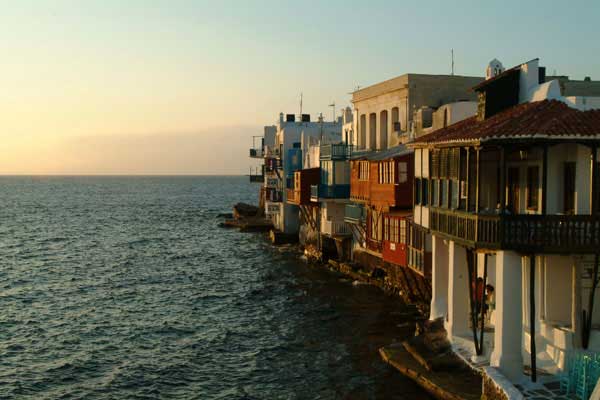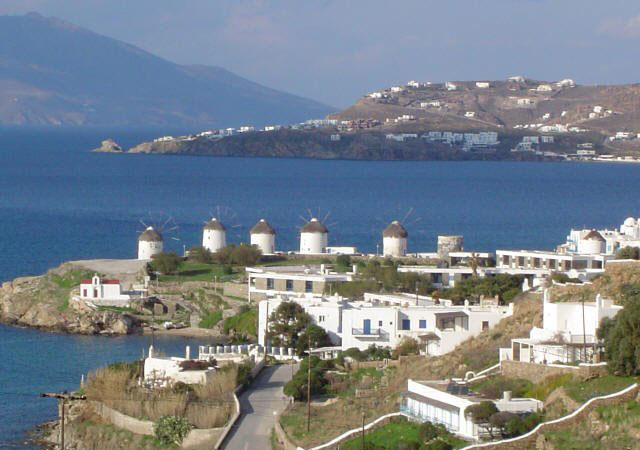Town Hall
The Town Hall, built in 1780, is an early neoclassic-style, two-story building with a tiled roof. It was constructed following the 1760-1774 conflict between Russia and the Ottoman Empire, in order to house the Russian Consul General of the Archipelago. A few years later it came under the jurisdiction of the Community (the local authority of the island that was in operation before the revolution) to house, up to the present day, the offices of the Municipality of Mykonos.
"Little Venice"
Little Venice is the picturesque part of the city, that lies between Castro and Scarpa, with the characteristic colourful wooden balconies “hanging” above the sea.
One can enjoy here one of the most breath-taking sunsets in Greece.

+++One can enjoy here one of the most dramatic sunsets in Greece.
The Windmills
Perhaps one of the most characteristic elements of Mykonos is the Mills. The most photographed are the mills located in the south of Chora, between the picturesque Alefkandra and the district of Niohori, and impress every visitor with their all-white, overwhelming size, lined in a row, facing the sea.

The windmills appear to have been on the islands of Greece from the early 15th century. It is during the end of the 18th century and into the mid-19th century that the windmills were found to operate in Mykonos. Apart from Chora, windmills also were used in Ano Mera. In general, the frequency of strong winds in Mykonos advocated the use of mills for the grinding of the wheat.
The ownership of the mills was usually consumer cooperative. The owners were wealthy landowners, merchants, sailors, etc. Namely they were people who had authority and power in every local community. The mills were also the property of some monasteries such as the Panagia Tourliani, mainly as a result of donations. It was towards the middle of the 20th century, when the mill trade was coming to an end that a few mill owners had become millers.
There are many reasons as to why there were so many windmills in the Cyclades. One is due to the fact that they are amongst the windiest areas of the Mediterranean. Mykonos is exceptionally windy, where the calm days do not exceed an average of ten per year. With the aid of the windmills the inhabitants were able to take advantage of an abundant source of wind energy, and improve their living conditions in the small and remote communities that they lived in. In addition, at that time, flour was a main ingredient in their diet, and so the mill facilitated the grinding of the grain.
The island had over twenty mills but today, seven out of the ten are maintained. Until the end of the 20th century these mills would grind the wheat using the inexhaustible strength of the north wind. The windmills of Mykonos contributed to the economic growth of the island, and as it became a necessary port of call for the ships passing through the Aegean Sea, they would supply them with rusk. A monumental wood-burning oven is the famous "Gora Oven" in Niohori
+++The presence of windmills in insular Greece is documented in the beginning of 15th century. Later, during the late 18th century to the mid 19th century it is established that 28 windmills were functioning in Mykonos. Apart from the town, windmills functioned also in Ano Mera. Generally, high winds frequency in Mykonos favored this milling operation and marketing of cereals.
+++The ownership of the mills was generally cooperative. Their owners were wealthy landowners, merchants, sailors, etc., which means they were people who held power and authority in each local community. Mills also belonged to monasteries, such as the Virgin Tourliani , mainly as occasional effect of religious donations. During the 20th century, the final phase of the windmill history, several mill owners were millers themselves.
+++There are many reasons why windmills are popular in Cyclades, because Cyclades are the most windy areas of the Mediterranean. Mykonos is especially windy, as there are no more than ten windless days per year, on average. By having a windmill, the residents were able to take advantage of an abundant source of energy,wind, and as a result they were able to improve the conditions of their lives in their small and remote island communities.Additionally, during times when wheat and barley were the basic ingredients of the local diet, the windmill served as a time and labour-saving machine.
+++Today, seven, out of the ten mills which until beginning of the 20th century, would process the local wheat, using the unfailing power of the wind, have been preserved. The windmills of Mykonos, contributed to the economic growth of the island, as it became a necessary stop, for the purchase of paximadi (ship’s biscuit), for ships playing the Aegean. The “Bakery of Yiora”, in Neochori, with its wood-burning over, is a working example of the bakeries of past time.
Bonis Windmill
This mill was probably built in the 16th century and is one of the famous "Apano Mills". This once belonged to the Boni family, whose roots were from Crete and Italy.

The windmills of Mykonos are cylindrical, built from stone and are three-stories tall. The ground floor which is above ground level is used to gather and weigh the flour. The middle floor flour is where the flour is collected, while the ancient grinding machine is on the second floor. The big windmill’s sail is divided into 12 wooden spokes and the windmills are one of the most recognized landmarks of Mykonos.
+++This mill, originally belonged to the old Mykonian family of Bonis, the Mykonian windmill is a stone-built three-storey and cylindrical construction. The ground floor is used for the collection and weighing of the grain. The flour is collected on the middle floor, while there is an ancient milling machine on the second floor. The sail-wheel of Bonis Windmill has twelve wooden spokes with the same number of triangular sails.
Lena's House
The Lena House is a 19th-century Mykonian house and is one of the annexes of the Folklore Museum of Mykonos. It took its name from the last home-owner, Lena Skrivanou, and it is a 19th-century, one storey building. Located in Tria Pigadia, in the town of the island it still has its antique furnishings. It operates independently and is open to the public so that one can encounter a typical 19th-century Mycenaean medieval house.
The floor plan of the house is typical of its period. In the entrance there is a large main room with a wide arch in the centre supporting the roof. Going further in, there are two smaller rooms. At the back of the house, there is a service room and also two small courtyards, with a replica of a dovecote.
The original furnishings of the house are from the 19th Century or earlier. The donors and the Folklore Museum itself have enriched the décor with the addition of several modern items. There one may see an interesting collection of European and domestic furniture of the 19th century as well as decorative pieces of household. (Embroidery, mirrors, etchings, etc.)
Drafaki, Vrissi
Interesting small monuments are scattered in various rural areas and in the South of Chora, at Drafaki (Paspari) one can see some old but well-preserved small chapels.
A few years ago, an unusual Cyclades domed tomb from the Mycenaean period, was found in Vrissi. The interior of the tomb being filled with riches and with interesting content confirms the land's particular relations with the Mycenaean Hellenic centres. In the same area splendid dovecotes located in ancient gardens, with their distinctive decoration of the time can also be seen.
In the Mykonian countryside, the ruins of some ancient squares and round towers are maintained. It is thought that they were part of the defensive system the island had: The tower in Limnos, 10 meters in diameter. approx., and a height of 1.80 m., with traces of a defence barricade and two early Christian churches adjacent to it. The tower at Portes, which is dominated by Platys - Gialos, with a smaller diameter (3.5m), impresses with its preserved porthole that forms three large, carved, granite blocks.
In addition, there are ancient wells that are still in use till the present day. For example there is the well of Giannaro, an underground tank built from granite with a staircase to ease the descent into the water. Another well, the 'Pouados', with steps on the side to ensure easy access, is maintained under the peripheral road of Tourlos - Korfos, not far from Tagus